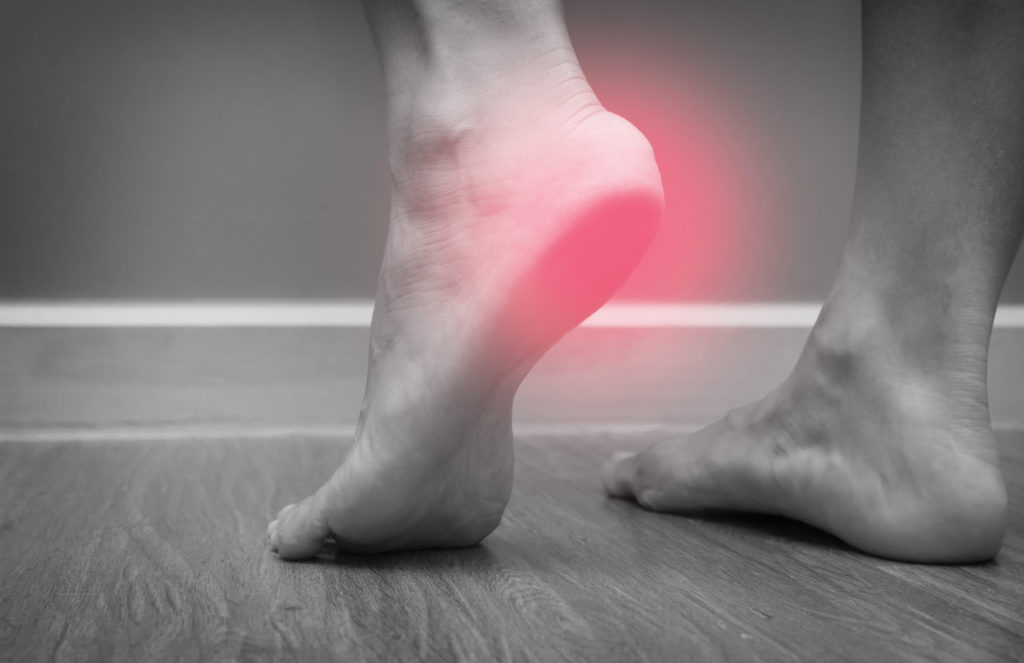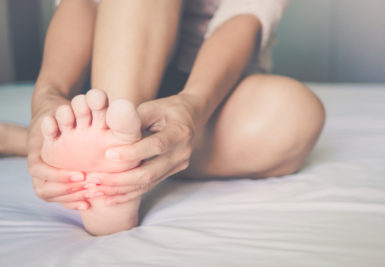THIS IS PART OF THE ULTIMATE GUIDE TO FOOT AND ANKLE INJURIES
Plantar fasciitis is one of the most common causes of heel pain. On average, it takes about six months to fully eliminate plantar fasciitis pain with treatment and up to 18 months without treatment, according to Medical News Today.
But you don’t have to live in pain. There are many different stretches you can do to relieve plantar fasciitis pain along with a variety of plantar fasciitis treatment exercises.
Dr. Mihir Patel, OrthoIndy foot and ankle doctor discusses plantar fasciitis stretches and exercises, how to exercise with plantar fasciitis, the best shoes for plantar fasciitis and how you can continue to exercise with plantar fasciitis.
Make an appointment with a foot and ankle specialist
What is plantar fasciitis?
The plantar fascia is the long, thin ligament that supports the arch of the foot and lies beneath the skin on the bottom of the foot. The plantar fascia absorbs the high stresses and strains we place on our feet.
The pain usually develops when too much pressure on the bottom of the foot damages or tears the plantar fascia tissues. This results in inflammation, heel pain and stiffness.
Most commonly it develops without a specific reason. But, obesity, tighter calf muscles, a high arch, repetitive impact activities or new activity may play a role in the likelihood of it developing.
The pain is usually the worst within the first few steps after waking up. Long periods of standing or getting up after prolonged sitting is also a trigger.
Make an appointment with a foot and ankle specialist
Plantar fasciitis stretches
Plantar fasciitis stretches can help relieve pain and stiffness from the ligament in the bottom of your foot and the calf muscle. The following exercises can help treat foot pain:
- Plantar fascia stretches on a step
- Gastroc stretch on the wall
- Soleus stretch on the wall
- Seated plantar fascia stretch
- Towel scrunches
- Seated plantar fascia mobilization with a small ball
Download the plantar fasciitis home exercise program for step by step instructions
Dr. Patel also has other suggestions on how to relieve stiffness and pain from your plantar fascia.
“Patients can ride an exercise bike or elliptical to maintain their fitness, and at the end of their workout can ride the exercise bike or elliptical backward to help stretch the calf muscle and hamstring muscles,” said Dr. Patel. “Patients can also walk forward and backward in a swimming pool or do the bicycle kick with a floatation device in the deep end to help get the ligament loosened up.”
What are the best shoes and insoles for plantar fasciitis?
Shoes cannot treat the condition, but they can bring you more comfort. First, it is important to figure out what type of foot and arch you have. There are three different foot types: Neutral arch, low arch and high arch. The height of your arch affects the direction and severity of the way your foot rolls or pronates.
- Neutral arch: It causes the foot to roll to a healthy spot.
- Low arch: It causes the foot to roll excessively inward, or overpronate.
- High arch: It causes the foot to roll in only slightly at impact, or under pronate.
Once you know what arch you have, you can pick an appropriate shoe for you. Look for the following four things when buying a shoe for plantar fasciitis:
- Ample arch support
- A firm, but flexible midsole
- If you’re using plantar fasciitis insoles, a removable insole
- Cushioning in the forefoot
Dr. Patel suggests a thicker, stiff sole shoe because it’s more supportive for patients with plantar fasciitis. “Rocker soles also help reduce the symptoms which can be found in a variety of brands including Hoka, New Balance, Skechers, Merrill and Born,” he said.
Download the Shoe Buying Guide
What is the best exercise for plantar fasciitis?
You might be wondering what cardio exercises you can do with plantar fasciitis. Plantar fasciitis physical exercises that do not require joint pounding are best.
Foot exercises for plantar fasciitis include:
- Swimming: It keeps you free of physical pounding on your body and is an exercise that is easy on your feet and other joints.
- Water Aerobics: It is another choice, if you don’t prefer to swim.
- Rowing Machine: It’s intensive cardio that engages your lower body without the impact or pounding.
- Running on the Elliptical Machine: It eliminates the pounding that comes with running but provides your body the same health benefits.
- HIIT with Weightlifting: You can incorporate HIIT movements, a high-intensity interval training, that can help you get a sweat in along with lifting weights which increases your heart rate.
- Biking: It’s important to use a firm surface shoe when biking to get the support you need without the hard-hitting impact of running.
- Yoga: Yoga incorporates movements that are easy on your joints, keeps your muscles flexible, and strengthens your muscles, all at once.
Dr. Patel said Pilates can helps as well. “Doing the same exercise every other day helps with cross-training and reducing the chance of a separate overuse injury,” he said. “Cross-training with low impact activities on consecutive days can be done as well so long as one is not sore in the same muscle groups.”
Learn more about foot and ankle injuries.
Schedule an appointment
Your well-being is important to us. Click the button below or call us to schedule an appointment with one of our orthopedic specialists. If your injury or condition is recent, you can walk right into one of our OrthoIndy Urgent Care locations for immediate care. For rehabilitation and physical therapy, no referral is needed to see one of our physical therapists.





